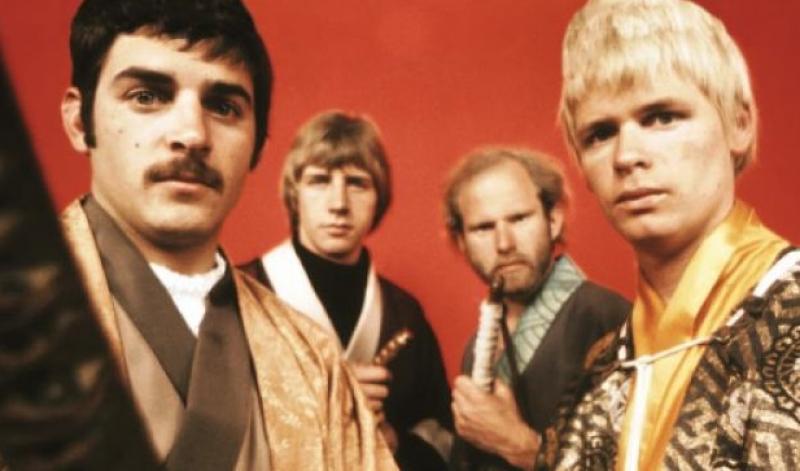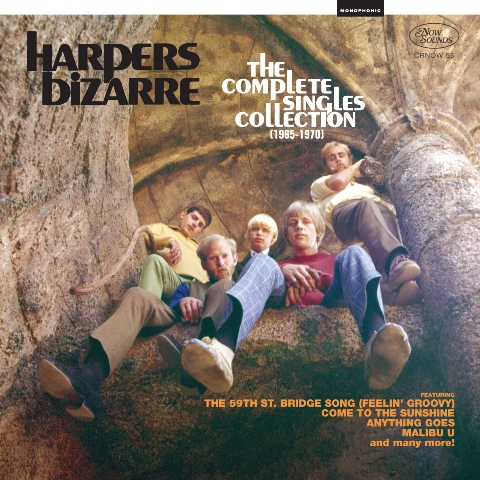Reissue CDs Weekly: Harpers Bizarre | reviews, news & interviews
Reissue CDs Weekly: Harpers Bizarre
Reissue CDs Weekly: Harpers Bizarre
A celebration of California’s pop at its most flawless

While Harpers Bizarre’s US Top 20 version of Simon & Garfunkel’s “The 59th Street Bridge Song (Feelin' Groovy)” will always be their single turned to by American oldies radio, its follow-up “Come to the Sunshine” defines their sound and musical attitude. Written and previously recorded by Van Dyke Parks, it captures an irresistibly effervescent Californian harmony pop which painted a sonic picture of the West Coast in 1967 as balmy, beautiful and seductive.
Of course, the sunshine would soon be blotted out by Charles Manson and Altamont but the rosiness of this beatific portrayal of California touched almost everything recorded by Harpers Bizarre, as amply demonstrated by The Complete Singles Collection 1965-1970. The CD compiles their 28 A- and B-sides for the Autumn and the Warner Brothers labels in chronological order of release. All but two of the later tracks are in mono, as they were on the original 45s. The booklet’s track-by-track annotation includes the input of band member Dick Scoppettone.
 Despite being closely associated with Parks, Harpers Bizarre were not innovators and had no in-house prodigy like Brian Wilson to compose and arrange their recordings. After ending up on Warners in 1966, they recorded only five of their own compositions as sides for singles. Like their fellow former-Autumn label band The Beau Brummels, they transferred to Warners after their original imprint was bought out by the major label.
Despite being closely associated with Parks, Harpers Bizarre were not innovators and had no in-house prodigy like Brian Wilson to compose and arrange their recordings. After ending up on Warners in 1966, they recorded only five of their own compositions as sides for singles. Like their fellow former-Autumn label band The Beau Brummels, they transferred to Warners after their original imprint was bought out by the major label.
Also like The Beau Brummels – America’s first convincing home-grown riposte to The Beatles – San Francisco was their original stamping ground. Parks, the songs of Randy Newman and Harry Nilsson, producer Lenny Waronker, arranger Perry Botkin Jr and the input of session players like Ry Cooder came their way after the move to Los Angeles and Warners. The band which recorded originally as The Tikis for Autumn would come to exemplify their new city’s sound.
The version of “The 59th Street Bridge Song (Feelin' Groovy)” was so different to their Beau Brummels-styled, folk rock-ish recordings as The Tikis that a new band name was adopted. As Harpers Bizarre, their singles balanced a smooth, upbeat harmony pop with versions of old-time songs like “Chattanooga Choo Choo”, Cole Porter’s “Anything Goes”, “Look to the Rainbow” from the soundtrack of Finian’s Rainbow and the nostalgic-sounding “Battle of New Orleans”. Their contemporarily written songs included Newman’s quirky “The Debutante’s Ball”, Joni Mitchell’s “Both Sides Now” and Parks’ soaring “Come to the Sunshine”.
Considering the mix of self-penned songs, those from hip contemporary writers and the covers of mum’s-and-dad’s music (a formula setting them apart from their fellow harmony pop travellers The Association), it is maybe surprising that Harpers Bizarre had a unified sound. The band were consummate, strong singers and their creamy yet solid harmonies define everything they did. They were one of California’s best in the period, never went heavy and were never overtly fashionable. Those latter two aspects help keep their music fresh.
For anyone with an interest in California’s pop at its most flawless, this is essential. For the less-historically minded, The Complete Singles Collection 1965-1970 will still be a joy.
Share this article
more New music
 theartsdesk on Vinyl: Record Store Day Special 2024
Annual edition checking out records exclusively available on this year's Record Store Day
theartsdesk on Vinyl: Record Store Day Special 2024
Annual edition checking out records exclusively available on this year's Record Store Day
 Album: Jonny Drop • Andrew Ashong - The Puzzle Dust
Bottled sunshine from a Brit soul-jazz team-up
Album: Jonny Drop • Andrew Ashong - The Puzzle Dust
Bottled sunshine from a Brit soul-jazz team-up
 Album: Pearl Jam - Dark Matter
Enduring grunge icons return full of energy, arguably their most empowered yet
Album: Pearl Jam - Dark Matter
Enduring grunge icons return full of energy, arguably their most empowered yet
 Album: Paraorchestra with Brett Anderson and Charles Hazlewood - Death Songbook
An uneven voyage into darkness
Album: Paraorchestra with Brett Anderson and Charles Hazlewood - Death Songbook
An uneven voyage into darkness
 theartsdesk on Vinyl 83: Deep Purple, Annie Anxiety, Ghetts, WHAM!, Kaiser Chiefs, Butthole Surfers and more
The most wide-ranging regular record reviews in this galaxy
theartsdesk on Vinyl 83: Deep Purple, Annie Anxiety, Ghetts, WHAM!, Kaiser Chiefs, Butthole Surfers and more
The most wide-ranging regular record reviews in this galaxy
 Album: EMEL - MRA
Tunisian-American singer's latest is fired with feminism and global electro-pop maximalism
Album: EMEL - MRA
Tunisian-American singer's latest is fired with feminism and global electro-pop maximalism
 Music Reissues Weekly: Congo Funk! - Sound Madness from the Shores of the Mighty Congo River
Assiduous exploration of the interconnected musical ecosystems of Brazzaville and Kinshasa
Music Reissues Weekly: Congo Funk! - Sound Madness from the Shores of the Mighty Congo River
Assiduous exploration of the interconnected musical ecosystems of Brazzaville and Kinshasa
 Ellie Goulding, Royal Philharmonic Concert Orchestra, Royal Albert Hall review - a mellow evening of strings and song
Replacing dance beats with orchestral sounds gives the music a whole new feel
Ellie Goulding, Royal Philharmonic Concert Orchestra, Royal Albert Hall review - a mellow evening of strings and song
Replacing dance beats with orchestral sounds gives the music a whole new feel
 Album: A Certain Ratio - It All Comes Down to This
Veteran Mancunians undergo a further re-assessment and reinvention
Album: A Certain Ratio - It All Comes Down to This
Veteran Mancunians undergo a further re-assessment and reinvention
 Album: Maggie Rogers - Don't Forget Me
Rogers continues her knack for capturing natural moments, embracing a more live sound
Album: Maggie Rogers - Don't Forget Me
Rogers continues her knack for capturing natural moments, embracing a more live sound
 theartsdesk at Tallinn Music Week - art-pop, accordions and a perfect techno hideaway
A revived sense of civilisation thanks to dazzlingly diverse programming
theartsdesk at Tallinn Music Week - art-pop, accordions and a perfect techno hideaway
A revived sense of civilisation thanks to dazzlingly diverse programming
 Album: Lizz Wright - Shadow
Brilliant album from superlative vocalist
Album: Lizz Wright - Shadow
Brilliant album from superlative vocalist

Add comment